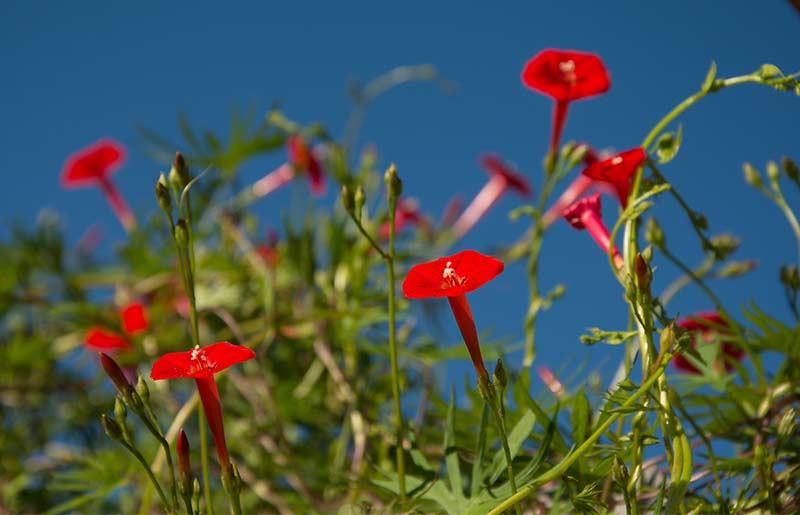
Gardening Corner: All About Cardinal Climbers and November Gardening Tips
November Plant of the Month: Cardinal Climber
by Becky Lowicki, Master Gardener
Sporting a vibrant, regal red trumpet bloom as stunning as its namesake songbird, this profuse climber is making a resurgence across the southern United States.

Comprised of a cross more than 100 years ago between a red morning glory (Ipomoea coccinea) and cypress vine (I. quamo- clit – as the parent) both native to Central and South America, by Logan Sloter of Columbus Ohio, in 1897, this hybrid descended from the single plant which took 11 years to produce a single seed.
Within the morning glory family (Convolvulaceae), Cardinal Climber has been grown as an ornamental both for its attractive foliage and prolific flowers. The alternate leaves are halfway between the finely divided, feathery leaves of cypress vine and the entire, heart-shaped leaves of red morning glory.
The triangular, medium green leaves divide into numerous deep, narrow lobes of varying numbers (usually 3-7 pairs plus one wider terminal lobe), resembling little palm leaves and giving a lacy appearance to the foliage.
This vigorous, twining tropical plant grows up to 10 feet long, growing slowly under cool conditions, then rapidly growing and blooming in hot, humid weather. The slender, flattened stems intertwine and tangle amongst themselves or whatever they are rambling up or over.
Ranking a 10 on the Earth–Kind® index, which indicates a high adaptability to the average environmental conditions in the Houston region, this gem’s requirements are as follows:
- Heat tolerance: High, prefers full sun or part shade
- Water Requirements: Low, prefers moist, well-drained soil but will tolerate dry soil if watered regularly
- Soil Requirements: Low
- Pest Tolerance: High
- Fertility Requirements: Low, unless the soil is very poor, does not require fertilizer
November Gardening Calendar
by Karen Shook, Master Gardener
As the weather cools, our garden task list is getting shorter. Personally, a break from mowing the lawn twice a week sounds good. Although mowing is good exercise!
November comes with a chance of frost. Historically, first frost in Zone 8 is November 7 to November 28. First frost in Zone 9 is November 25 to December 13. Forecasts show temperatures slightly above the historic average of 62° F. Precipitation has been hit or miss, but expect a bit lower than normal.
Gather those fallen leaves and use them as mulch or as the “brown” in your compost.
Perennials and Ornamental Grasses
- Clean up perennial beds and mulch. A thick mulch over the base of the plant will help protect tender perennials.
Annuals
- Plant cool season annuals. Fertilize and mulch. Pansies and violas are pretty cold tolerant. But you can also still plant others like dusty miller, snapdragons, and stock.
Bulbs
- Finish planting spring bulbs (except tulips and hyacinths . . . patience, wait until December for those).
- Cut back foliage that has browned. Mark the location of dormant summer bulbs. It is also a good idea to mark where you plant spring bloomers so you don't accidentally dig them up or damage them digging in the vicinity.
Shrubs
- Shrubs can be planted or moved in Nov. m Avoid severe pruning.
Natives
- You can still spread wildflower seeds in zones 8b to 9 in early November. Rake the soil, scatter seeds, lightly rake in and water.
Lawns
- Apply pre-emergent herbicide in early November if you didn't do this in Oct.
- Gather fallen leaves so they don't shade your lawn. Or using a mulching mower, mulch them down into the lawn to help cover the soil surface and deter cool season weeds.
Edibles (vegetables, herbs, berries, fruits)
- See the following link for recommended planting times: Harris County Vegetable Planting Guide
Groundcovers and Vines
- You can plant hardy perennial groundcovers and vines.
They will not grow, but will establish roots for better growth in spring. - Mulch tender vines, covering the roots and lower stems.
Source: Harris County Master Gardeners Urban Dirt Newsletter (November 2022 Edition)
About Urban Dirt
Each month, Harris County Master Gardeners publishes an informative, resourceful newsletter entitled "Urban Dirt". This article was derived from the November 2022 edition. To read the November 2022 edition of this newsletter, click the button below.
URBAN DIRT - NovembER 2022 EDITION









